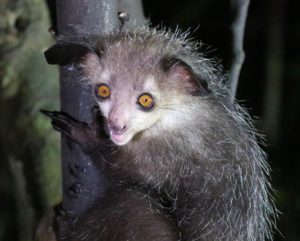Conservation through Storytelling

To view the photo-rich magazine version, click here.
Originally appears in the Winter 2019 issue.
To print the aye-aye survey, please follow this link.
A BUTTERFLY, A SQUIRREL, or a bird can add a charming element to a backyard barbeque, but change those animals to a bee, a mouse, or a bat and the atmosphere suddenly changes. Why are some animals welcome and others not? I once saw a young child in a stroller watching a bee on a nearby flower with fascination. Her mother saw the bee and yanked her away with a scream. The young child started to cry, learning that bees are bad, and she should be afraid of them, possibly carrying this belief with her into adulthood. On a broader scale, some odd-looking creatures are facing extinction because folklore within certain cultures describes them as “evil” or “taboo”.1 Ugliness is often associated with negative feelings such as uneasiness, dislike, and revulsion.2 These feelings prevent people from contributing to conservation efforts needed to ensure the continued health of the species. This factor may make it necessary to change the image of the less attractive creatures. The following lesson plan is designed to alter negative images through storytelling. The lesson is intended for elementary level but can be easily adapted for older students. The class studies an animal on the endangered species list, writes a story about the animal and creates a book that can be shared with others.
Storytelling in nature
Storytelling can connect children to nature. Henegan states that children respond to the telling of environmental stories by becoming more environmentally literate and engaged with nature.3 Firth claims that when we become immersed in a tale, it fosters an increasing empathy for the characters and situations of that tale.4 Whether nature stories are told to the students by adults or the students create the nature stories themselves, the story and the discussion that accompanies it make students more aware of nature and, hopefully, gain an appreciation for its importance. In the case of an endangered, or feared animal, storytelling can be an effective tool to calm fears and to teach about the significance of the animal to its habitat and ecosystem. The students, may share that information and appreciation with their parents and family members.5
This content is restricted to subscribers only.
If you are not yet a subscriber, please consider taking out a subscription here.
If you are an existing subscriber, kindly log in or contact us at info@greenteacher.com for more information.





